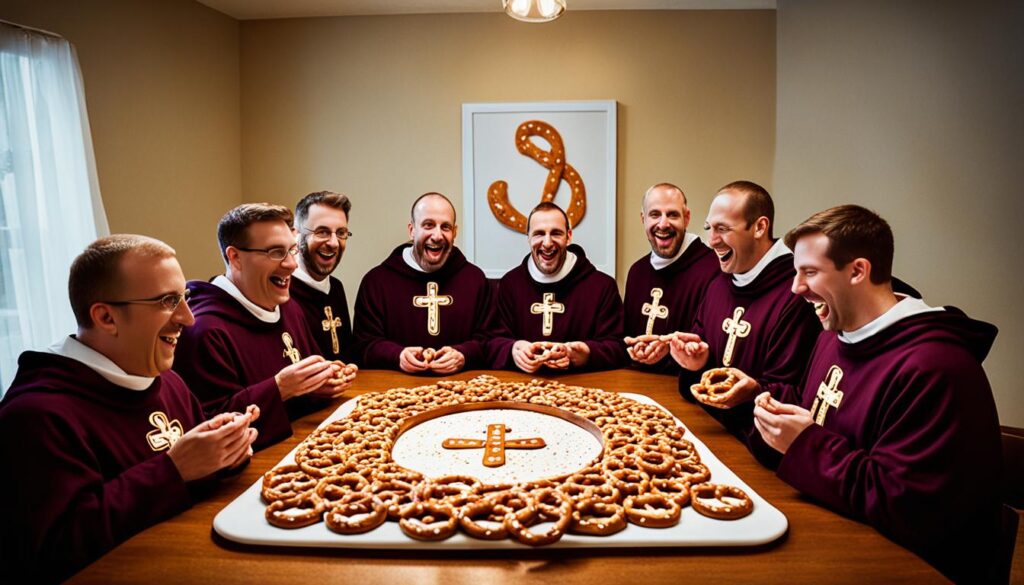The pretzel, a beloved snack worldwide, has roots in Catholic monasteries. Monks created this twisted dough as a reward for the faithful. Its journey from monastery to global popularity is a tale of faith and culinary creativity.
The pretzel’s story began in the 7th century. Monks in Italy or France baked these treats to encourage children’s prayers. They called them “pretiola” or “little rewards.”
The pretzel’s shape mimics arms crossed in prayer. Its three holes represent the Holy Trinity. This design reflects the snack’s religious origins.
The word “pretzel” may come from “bracchiatus,” Latin for “arm.” As Catholicism spread in medieval Europe, so did pretzels. They became popular during Lent, a fasting period.
Pretzels fit Lenten dietary rules perfectly. Their simple ingredients – flour, water, and salt – were allowed during this time. This made them a favored snack for the faithful.
Key Takeaways
- Catholic monks invented pretzels in the 7th century as a reward for children learning their prayers
- The pretzel’s shape resembles arms crossed in prayer, with the three holes representing the Holy Trinity
- The word “pretzel” may originate from the Latin word “bracchiatus,” meaning “arm”
- Pretzels became popular throughout Europe during the Middle Ages, especially during Lent
- The simple ingredients of flour, water, and salt were permitted during the Lenten period of fasting
The Monk’s Twist: Pretzels as a Reward for Prayer
The monk’s invention of the pretzel is a captivating story. It showcases the snack’s deep Catholic roots. Around 610 CE, a monk created twisted bread as a prayer reward for his students.
The monk named these treats “pretiola,” meaning “little rewards” in Latin. He said the pretzel’s three holes represented the Holy Trinity. This story highlights the pretzel’s connection to Catholic faith.
Pretzels were perfect for Lent, made with simple ingredients. They provided food and symbolized devotion. The pretzel shape became an icon of the Church’s impact on food traditions.
The popularity of pretzels grew along with their religious significance. The monk’s invention spread across Europe, becoming a beloved snack. Pretzels reminded people of prayer’s importance in daily life.
Today, the pretzel’s unique shape still fascinates people. It stands as a testament to the lasting legacy of this meaningful prayer reward.
Pretzels in the Middle Ages: A Symbol of Good Fortune
In medieval times, pretzels gained new meaning beyond their religious roots. Monks gave pretzels to the poor as a symbol of spiritual fulfillment. The snack quickly became a lucky symbol in art and literature.
Herrad of Landsberg’s 12th-century encyclopedia, Hortus Deliciarum, showed pretzels as crucial to feasts. This depicted them as symbols of abundance and good fortune. The pretzel’s lucky reputation grew throughout the Middle Ages.

By the 17th century, pretzels symbolized undying love. Swiss royal couples used pretzels in weddings to seal their bond. This may have inspired the phrase “tying the knot.”
German children wore pretzel necklaces on New Year’s for luck. This tradition further cemented the pretzel’s status as a fortune-bringer. The pretzel’s journey from religious reward to cultural icon is remarkable.
Monks’ Pretzel Invention: Saving the City of Vienna
In 1529, Vienna faced a siege by the Ottoman Turks. The invading army tried to tunnel beneath the city walls. Pretzel-baking monks in a monastery basement heard suspicious sounds and alerted the city’s defenders.
The bakers’ quick thinking proved invaluable to Vienna’s defense. Their warning helped thwart the attack, forcing the Ottomans to abandon their plans. This saved Vienna from falling into enemy hands.
The monks’ role in saving the city became legendary. Their actions were forever etched in Viennese history.
The Austrian emperor honored the pretzel bakers for their crucial contribution. He granted them a unique coat of arms featuring lions holding a pretzel. This symbol of bravery became a treasured emblem.
Today, the coat of arms still adorns some traditional European pretzel shops. It serves as a reminder of the pretzel’s surprising role in Vienna’s history.
This story adds a fascinating chapter to the pretzel’s rich history. It shows how a simple snack became a symbol of faith and good fortune. The pretzel represents the enduring spirit of its crafters through the centuries.
Pretzels in America: From German Immigrants to Mass Production
German immigrants brought pretzels to America, settling in Pennsylvania around 1710. These skilled bakers introduced their traditional recipes and techniques. As the German community grew, so did the pretzel’s popularity.
Julius Sturgis founded one of the first commercial pretzel bakeries in 1861. He developed hard pretzels, which had a longer shelf life. This innovation allowed pretzels to be sold farther from the bakery.
Sturgis’ bakery, now the Julius Sturgis Pretzel Bakery, remains a historic landmark. It stands as a testament to early pretzel-making in America.
The Reading Pretzel Machinery Company revolutionized the industry in 1935. They introduced the first automated pretzel maker. This invention could create 245 pretzels per minute, up from 40 by hand.
The automated maker boosted efficiency and enabled mass production. It allowed for widespread distribution of pretzels across the country.
Pennsylvania remains the pretzel-making capital of the United States. It produces 80% of the nation’s pretzels. The state’s rich history in pretzel-making dates back to German immigrants.

Leave a Reply